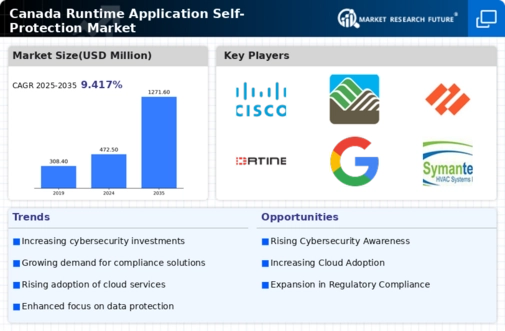Increasing Cybersecurity Threats
The runtime application-self-protection market is experiencing growth due to the escalating cybersecurity threats faced by organizations in Canada. With a reported increase in cyberattacks, businesses are compelled to adopt advanced security measures. In 2025, it is estimated that cybercrime could cost Canadian businesses over $10 billion annually. This alarming trend drives the demand for runtime application-self-protection solutions, which provide real-time protection against vulnerabilities and attacks. Organizations are increasingly recognizing the necessity of integrating these solutions into their software development lifecycle to safeguard sensitive data and maintain customer trust. As the threat landscape evolves, the runtime application-self-protection market is likely to expand, with companies prioritizing investments in security technologies to mitigate risks.
Regulatory Compliance Requirements
The runtime application-self-protection market is significantly influenced by the stringent regulatory compliance requirements imposed on businesses in Canada. Organizations are mandated to adhere to various data protection laws, such as the Personal Information Protection and Electronic Documents Act (PIPEDA). Non-compliance can result in hefty fines, which may reach up to $100,000 for organizations. As a result, companies are increasingly adopting runtime application-self-protection solutions to ensure compliance with these regulations. These solutions help in monitoring applications for vulnerabilities and ensuring that sensitive data is adequately protected. The growing emphasis on compliance is expected to drive the runtime application-self-protection market, as organizations seek to avoid legal repercussions and enhance their security posture.
Shift Towards Cloud-Based Solutions
The runtime application-self-protection market is witnessing a shift towards cloud-based solutions, driven by the increasing adoption of cloud computing among Canadian enterprises. As organizations migrate their applications to the cloud, the need for robust security measures becomes paramount. In 2025, it is projected that over 70% of Canadian businesses will utilize cloud services, creating a substantial demand for runtime application-self-protection solutions that can operate effectively in cloud environments. These solutions offer scalability, flexibility, and enhanced security features, making them attractive to organizations looking to protect their applications from potential threats. This trend is likely to propel the growth of the runtime application-self-protection market as businesses prioritize securing their cloud-based applications.
Growing Awareness of Application Security
The runtime application-self-protection market is benefiting from the growing awareness of application security among Canadian businesses. As organizations increasingly recognize the importance of securing their applications, there is a heightened demand for solutions that provide real-time protection against vulnerabilities. In 2025, it is estimated that 60% of Canadian companies will prioritize application security in their IT budgets. This shift in focus is likely to drive investments in runtime application-self-protection technologies, as businesses seek to enhance their security measures and protect sensitive information. The increased awareness surrounding application security is expected to contribute to the expansion of the runtime application-self-protection market, as organizations strive to mitigate risks associated with application vulnerabilities.
Technological Advancements in Security Solutions
The runtime application-self-protection market is being propelled by technological advancements in security solutions. Innovations in artificial intelligence and machine learning are enabling more sophisticated runtime application-self-protection mechanisms that can detect and respond to threats in real-time. In 2025, it is anticipated that the integration of AI-driven security features will become a standard in runtime application-self-protection solutions. This evolution is likely to enhance the effectiveness of these solutions, making them more appealing to Canadian organizations. As businesses seek to leverage cutting-edge technologies to bolster their security frameworks, the runtime application-self-protection market is expected to experience significant growth, driven by the demand for advanced security capabilities.

























Leave a Comment